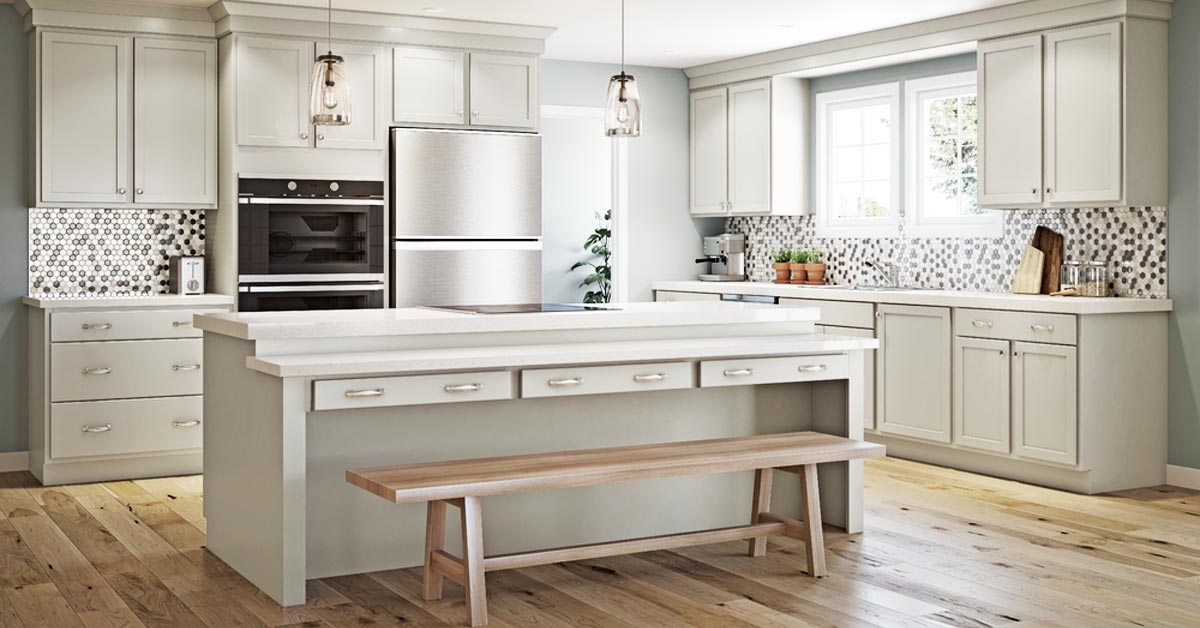
26 Sep The Ultimate Guide to Cabinet Materials
Kitchen remodels are a popular renovation in the Quad Cities. As homeowners prepare for the upcoming holiday season they want to entertain in a dazzling new dream kitchen. Of course there are plenty of decisions to be made and details to hammer out before the actual work begins. One of those details is your choice of cabinet materials. Here we offer the ultimate guide to cabinet materials so you can make that decision more easily.
Your Guide to Cabinet Materials
Cabinet materials have changed significantly in the last few decades. Not only have cabinet features changed as kitchens become more “smarter” but the materials used in the construction of today’s cabinets are far more durable and long-lasting with a greater focus on sustainability and the environment. Here is our ultimate guide to cabinet materials for your kitchen renovation.
Hardwood Cabinet Materials
The oldest and most popular choice for cabinets remains hardwood. Because hardwood is a natural material and comes directly from hardwood trees like maple, walnut, cherry, oak, hickory and birch (to name a few) there are variations in the patterns. These slight differences are what make hardwood cabinets unique and the number one choice among homeowners. Here are some more advantages of hardwood cabinet materials.
- Hardwood is an exceptionally durable substance and maintains its beauty for decades.
- You can easily repair hardwood cabinets and depending on the severity of the damage you can refinish the cabinets easily and quickly.
- There are so many hardwoods to choose from and each has it’s own distinct qualities as far as the color, finish and feel of your cabinets.
While hardwood cabinets have their advantages there are also some disadvantages to selecting this favorite material:
- Wood is a highly sought-after product and because of that, tends to be more expensive. In the case of supply chain issues wood is often difficult to get.
- Hardwoods are heavy and may require additional support at installation.
- Wood reacts to changes in humidity and temperature by contracting or expanding. Winter indoor heat or summer humidity may cause your cabinets to warp or crack.
Plywood
Plywood is a very versatile material and can be quite durable for cabinet materials. This choice for cabinets is created by laminating thin layers of wood on top of each other, fusing them with a mix of heat, glue and pressure. The grain patterns alternate to ensure strength and durability. Here are the advantages of plywood for your cabinets:
- Fairly impervious to the effects of humidity and temperature.
- Often considered as a component for cabinets in areas such as back, side panels, shelving and for the base of drawers.
- Of all the wood cabinet materials plywood provides the most strength so weight isn’t an issue.
- This very affordable material is easy to come by. Plywood is also easy to repair or replace.
Of course plywood cabinets do have certain disadvantages as well. Here are a few disadvantages of plywood:
- Plywood comes in different thicknesses so you’ll need to be sure the dimensions work for your design.
- Lower-end plywood cabinets have more gaps or even holes where the boards were fused. This could impair the durability and lifespan pf your cabinets.
Medium Density Fiberboard (MDF)
MDF is a composite material made from recycled wood fibers fused together and sealed under extreme pressure. The wood fibers are smaller making it very resilient and much stronger than low density fiber. Here are some more of the advantages of MDF:
- MDF is warp-resistant and moisture resistant
- The smooth finish of MDF means you can paint or stain to your preference.
- Installation of MDF cabinets is typically very easy
MDF cabinet materials do have some disadvantages including:
- Lack of support may cause sagging in drawers and cabinets.
- The manufacturing may involve volatile organic compounds such as formaldehyde which impacts indoor air quality, so you will want to do some research before you opt for this material.
Low Density Fiberboard (LDF)
LDF is also commonly referred to as particle board. It’s a good choice for its sustainability as LDF is an engineered wood made from recycled wood scraps like chips and sawmill shavings. LDF for cabinets requires a wood veneer or laminate finish. The particular advantages of LDF cabinet materials are:
- Extreme affordability
- Durability and strength, but make sure you get the higher-end LDF cabinets.
- LDF is light in weight and easy to install.
The disadvantages and drawbacks to using LDF cabinet materials are:
- Lower-end LDF cabinets are far weaker than any other type. They may not hold up under pressure or weight.
- If moisture penetrates the LDF it can degrade rapidly.
- Because of its weaker construction LDF is prone to sagging and may even come apart.
Wood Veneer
Wood veneer is a very thin layer of hardwood which is pressed to LDF or plywood. Depending on the core of the cabinet materials wood veneer can be fairly strong and durable. Here are some of the advantages of wood veneer cabinet materials:
- Wood veneer cabinets have the upscale aesthetic of hardwood but are more budget-friendly.
- Wood veneer is lightweight making it easy to work with.
There is only one real disadvantage to wood veneer cabinets:
- The veneer is simply a finish material so the interior of your cabinets and drawers will require your choice of plywood, LDF or MDF.
The Ultimate Source
There you have it! Seiffert Building Supplies ultimate guide to cabinet materials. If you’re looking at a new kitchen for the holidays or anytime please contact the Quad Cities most knowledgeable professionals in all things renovation and remodeling, Seiffert Building Supplies.

